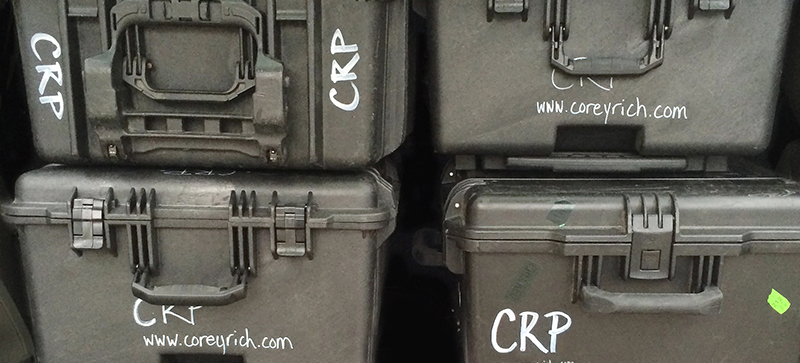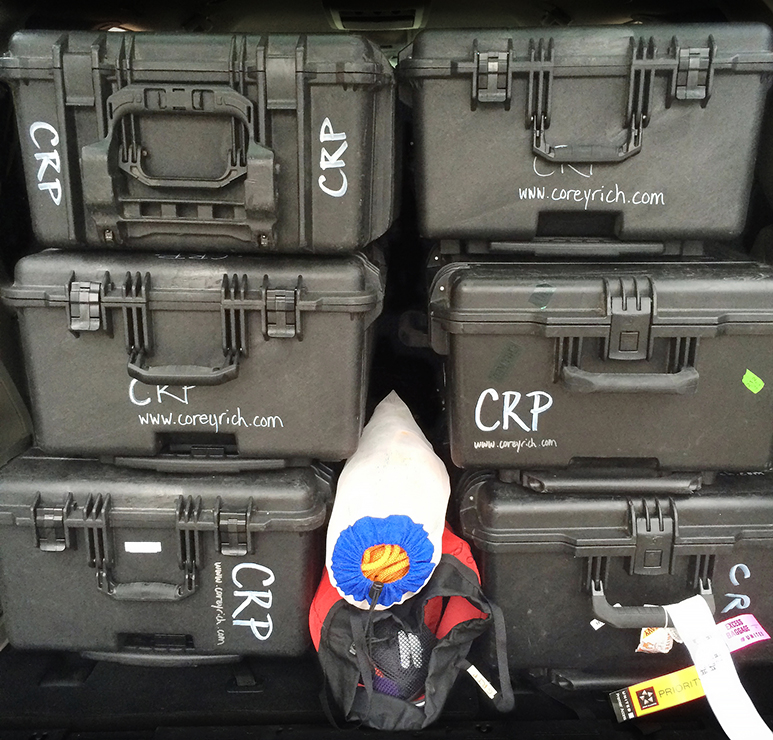Hi Corey,
I wanted to pick your brain quickly about traveling internationally with Pelican cases. Personally, I have always been a bit skeptical about using them because I fear that they scream, “There’s something expensive in here!”But I’m at the point where I no longer have a choice. I just picked up an Elinchrom Ranger lighting kit and a Pelican case seems to be the only logical way to transport it.
Would you mind going through any routines, policies, or tips you might have on making sure it arrives on the other side with everything still in it? Locks? Disguise?
Thanks for everything you are doing as a photographer. You are a huge inspiration and provide such a wealth of knowledge! Looking forward to finally getting out to the Adventure workshop next fall.
Thanks,
Matt
Hey, Matt! Thanks for the great questions. You guessed right, Pelican cases are the way to go. Whether you’re traveling by plane, boat or car, there is no better way to protect your valuable equipment than a big, black Pelican case.
To address your concerns about your luggage being lost, stolen or tampered with, I must say, it’s my experience that these concerns are outdated by today’s standards of modern air travel. I travel a lot, and I can’t think of the last time I lost a piece of luggage or had some equipment stolen.
Yes, Pelican cases do scream “Something expensive is in here,” but rather than trying to disguise that fact, I embrace it. For example, I use a white paint marker to write in large bold letters, “CRP,” which stands for Corey Rich Productions. I also write my URL: coreyrich.com, on a couple of spots on every case. Making the case easy to identify from a distant glance not only makes my life easier but it actually deters theft, too.
I will also write what type of equipment is inside the Pelican case on the outside of the case itself. If the contents are changing from shoot to shoot then I’ll simply stick a piece of white gaffer’s tape to the side/top of the case, and use a Sharpie to describe the contents.
That said, I will use slang or abbreviations. For example, I would never write “Nikkor 200-400mm f/4,” because that’s really putting a price tag on the contents. However, I will write, “200-400.”
We almost never use TSA locks—they’re crappy and often end up breaking off the luggage. Instead we use zip ties to “lock” the cases shut. We will also tape two extra zip ties onto the Pelican case, and write a note asking the TSA employees to please zip-tie the case back shut if they need open it to inspect its contents. Something simple like: “Please re-zip-tie if inspected.” And 9 times out of 10 they will do it.
If we’re traveling on an international expedition, such as to a location deep in the mountains of Pakistan or Peru, I will bring real locks for that extra peace of mind.
Here are some other tips for choosing, packing and traveling with your Pelican cases:
Size: Get the biggest size possible. Bag count is always a challenge when flying with your production equipment. The goal is to limit the number of bags you bring. I’d rather have extra space in my Pelican case than not enough because airlines charge per extra bag, regardless of its size. (These rules apply to soft luggage pieces as well.)
Types of Pelican cases: For our purposes, there are basically two classifications of Pelican cases: those whose contents will never change, and those whose contents will change from shoot to shoot.
For example, for video production, I have one large Pelican case that stores all our Small HD monitors and Paralinx systems. We have a half dozen Small HD monitors, from the DP4s to the DP7s, and a handful of Paralinx units that allow us to do an uplink from the MoVI, or from the camera at the end of a jib arm or on the RC helicopter.
In this case (literally), I use pick and pluck foam to customize the case to perfectly fit our quiver of Small HD monitors and Paralinx units.
We also have a few Pelican cases that we customize, depending on the job. To pack them, we will use Velcro foam dividers, which allow us to customize the case to our equipment needs.
Know your weight: Pelican cases are heavy, even when empty. It’s helpful to carry a little travel scale with you. First, you have to know the weight and baggage allowances of your airline. When you gain a certain status with an airline, those allowances go up, which will save you hundreds and potentially thousands of dollars in baggage fees. For us, the magic number is 70 pounds per piece. If you’re traveling on a media pass, then it might be as high as a 100 pounds. The last thing you want to do is get to the airport, realize your Pelican case is overweight, and scramble in the airport to re-pack with your expensive camera gear strewn all over floor beside the United check-in line.
Good luck! I’m happy to hear that you’ll soon be experiencing the “joy” that is traveling with upwards of a dozen 70-pound Pelican cases to your next shoot. Make sure you bring that assistant!
Do you have any good tips or tricks for using and traveling with Pelican cases? Share them here!


2 comments
The (EO)2 SnapPak System would be perfect for the Pelican 1510. Allows you to carry your 1510 on a technical backpack harness and still be able to open the case and access your equipment. You can even “snap” off the case, and snap it safely and securely to a wall for storage; to a motorcycle/ATV/UTV cargo rack for transport; even a boat; and use it as carryon – the same case, and the same mounting/carrier system… Check it out at EO2fastener.com
Hi CR
Thanks for the quick run-down – my workflow surrounding pelican cases is very similar to yours however I use inserts from TrekPak instead of P n’ P foam and it has truly changed the way I pack and travel with my gear in my 1600 and 1650 cases
Just my 5c
Morts
Comments are closed.